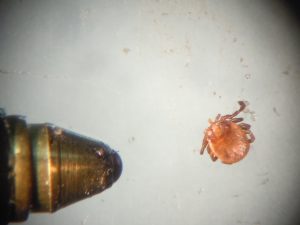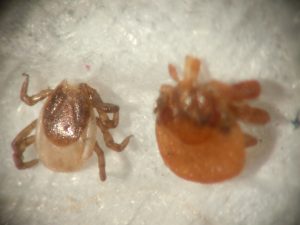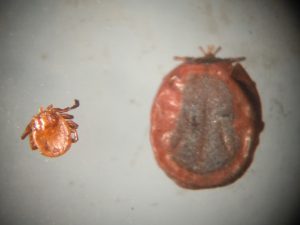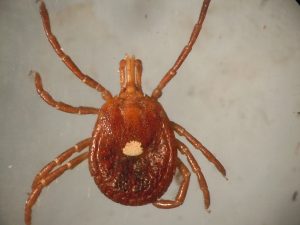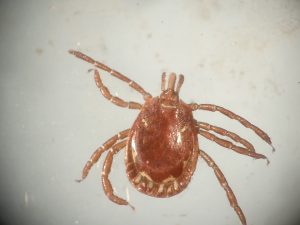Tick season is in full swing, and CCE’s Horticulture Diagnostic Lab answers questions daily with regard to ticks. While our lab does not test ticks, we do identify them. Why would this be a valuable service? I will answer this question and dispel many of the myths or fallacies associated with ticks here in this article.
Fiction: If a tick is tiny, then it’s a deer tick. Why would I need it identified?
Fact: Deer ticks, also known as blacklegged ticks (Ixodes scapularis) are significantly smaller than American Dog ticks (Dermacentor variabilis), however you should not use size as an identification feature. Lone Star ticks, Amblyomma americanum are also quite small, particularly the immature stage known as the nymph. Note photo 1 which shows a nymph lone star tick with a ball point pen tip, and photo 2, which compares the nymph of the deer tick (on the left, with missing mouthparts) with the nymph of the lone star tick (on the right).
Ticks also change in size considerably when they have been feeding. Note photo 3, of a lone star nymph on the left which had only started to feed in comparison to one partially engorged on the right.
Fiction: Only lone star ticks have the white spot so without a spot it’s a deer tick.
Fact: While it is true that the adult female Lone Star tick does have the conspicuous white spot on the scutum, or shield; the larvae, nymph and adult male Lone Star ticks do not have this spot. See photos 4 and 5 for the comparison of the adult female and the adult male. Be sure that if you are using the white spot as a feature to identify the tick that the scutum is clearly visible so that you have the tick oriented correctly and are viewing the dorsal or back of the tick. We often see ticks which are partially or fully engorged have a whitish area in the gut on ventral or belly side of the tick.
Fiction: I can prevent ticks by spraying the yard for ticks.
Fact: While spraying for ticks can lower numbers for a short period of time following application, animal movement into the property will move ticks into the property, and applications for the most part work until the pesticide dries. There are some organic materials that may offer some efficacy as a short term repellent. Excluding large mammals from your property by fencing will ultimately reduce tick numbers. The New York State Department of Health suggests the following precautions to reduce tick populations;
- Keep grass mowed.
- Remove leaf litter, brush and weeds at the edge of the lawn.
- Restrict the use of groundcover, such as pachysandra in areas frequented by family and roaming pets.
- Remove brush and leaves around stonewalls and wood piles.
- Discourage rodent activity. Clean up and seal stonewalls and small openings around the home.
- Move firewood piles and bird feeders away from the house.
- Manage pet activity; keep dogs and cats out of the woods to reduce ticks brought into the home.
- Use plantings that do not attract deer (contact your local Cooperative Extension or garden center for suggestions) or exclude deer through various types of fencing.
- Move children’s swing sets and sand boxes away from the woodland edge and place them on a wood chip or mulch type foundation.
- Trim tree branches and shrubs around the lawn edge to let in more sunlight.
- Adopt dryer or less water-demanding landscaping techniques with gravel pathways and mulches. Create a 3-foot or wider wood chip, mulch, or gravel border between lawn and woods or stonewalls. Consider areas with decking, tile, gravel and border or container plantings in areas by the house or frequently traveled.
- Widen woodland trails.
Fiction: I pulled the tick out before it burrowed under the skin.
Fact: Ticks do not burrow under the skin. They insert their specially designed mouthpart called a hypostome into the skin to feed. This is the only part of the tick that actually breaks the skin. In addition to the hypostome, they inject a cementing agent into the site to help them stay attached while they are feeding. To fully feed, to the point of engorgement, ticks feed for 2-7 days depending on the life stage of the tick (larvae, nymph, or adult).
Fiction: My doctor told me to come to the Horticulture Diagnostic Lab and have it tested for Lyme’s.
Fact: The Cornell Cooperative Extension Horticulture Diagnostic Lab does not test ticks for any disease pathogen. We can however identify ticks. Different ticks vector for different diseases. For a $11.00 lab fee we can tell you the species of tick, the life stage, if it had been feeding, the condition of the hypostome (which if broken off may still be in the skin and could potentially cause local infection), and will provide you information regarding what sort of diseases your particular tick could carry, symptoms of the various diseases, and general timeframe as to when symptoms would occur following a tick bite.
Fiction: The best way to remove a tick is to apply hand soap, Vaseline, nail polish remover or rubbing alcohol to the tick and then it will come off.
Fact: According to the New York State Department of Health, the best way to remove a tick is to grasp the tick near the mouth parts as close to the skin as possible from the side with a good pair of tweezers, and pull the tick in a steady upward motion away from the skin, and it should release. Applying anything to the tick that may irritate it to help it “let go” should be avoided as this can cause the tick to regurgitate its gut contents into your skin thereby increasing your chances of contracting a disease.
Fiction: The tick I had on my scalp must have fallen out of the trees in the woods.
Fact: Ticks found higher up on your body such as your scalp most likely crawled up there from your ankles or lower legs. Ticks are found in grasses and low growing vegetation so walking through these areas is how ticks are acquired. Most ticks are on vegetation no more than 1-2’ off the ground. If you have long hair it should be put up before yard work or gardening in areas where ticks are likely so that hair to ground contact does not occur.
Fiction: The tick I had was not a deer tick so that means I’m safe.
Fact: Not true! All ticks potentially carry disease. A tick that is not a blacklegged or deer tick could potentially carry human monocytic ehrlichiosis or Rocky Mountain spotted fever, so it’s still a good idea to be on the lookout for symptoms, and certainly contact your physician for additional medical advice. For more information about tick biology including diseases and symptoms take a look at our fact sheet on the website at the following link; https://s3.amazonaws.com/assets.cce.cornell.edu/attachments/5841/Tick_Biology_For_The_Homeowner.pdf?1421781733
Fiction: If I use a DEET repellent I should be protected from ticks.
Fact: While DEET repellents offer some protection from ticks, if you are going to be in wooded areas for extended periods of time you may have better success treating your skin with repellents of 30% or less DEET active ingredient, and applying permethrin type repellents to clothing or gear only. Permethrin is effective for two weeks or more if the clothing is not washed. As with all pesticides read all label directions before using. Tick repellents are not fool proof. The best way to be protected from tick bites is to check your lower body parts often when you are outdoors and do the “geek” thing; tuck your pant legs into your sock to make it more difficult for ticks to find your skin.
Now that you’ve learned a few things about ticks, pass the information along to friends, neighbors, family and doctors. Ticks are a part of our lives here on Long Island so remember to check yourselves after you’ve been in their territory. Ticks do not have to be the end of enjoying the great outdoors!
by Alice Raimondo, Horticulture Consultant, CCE Suffolk

